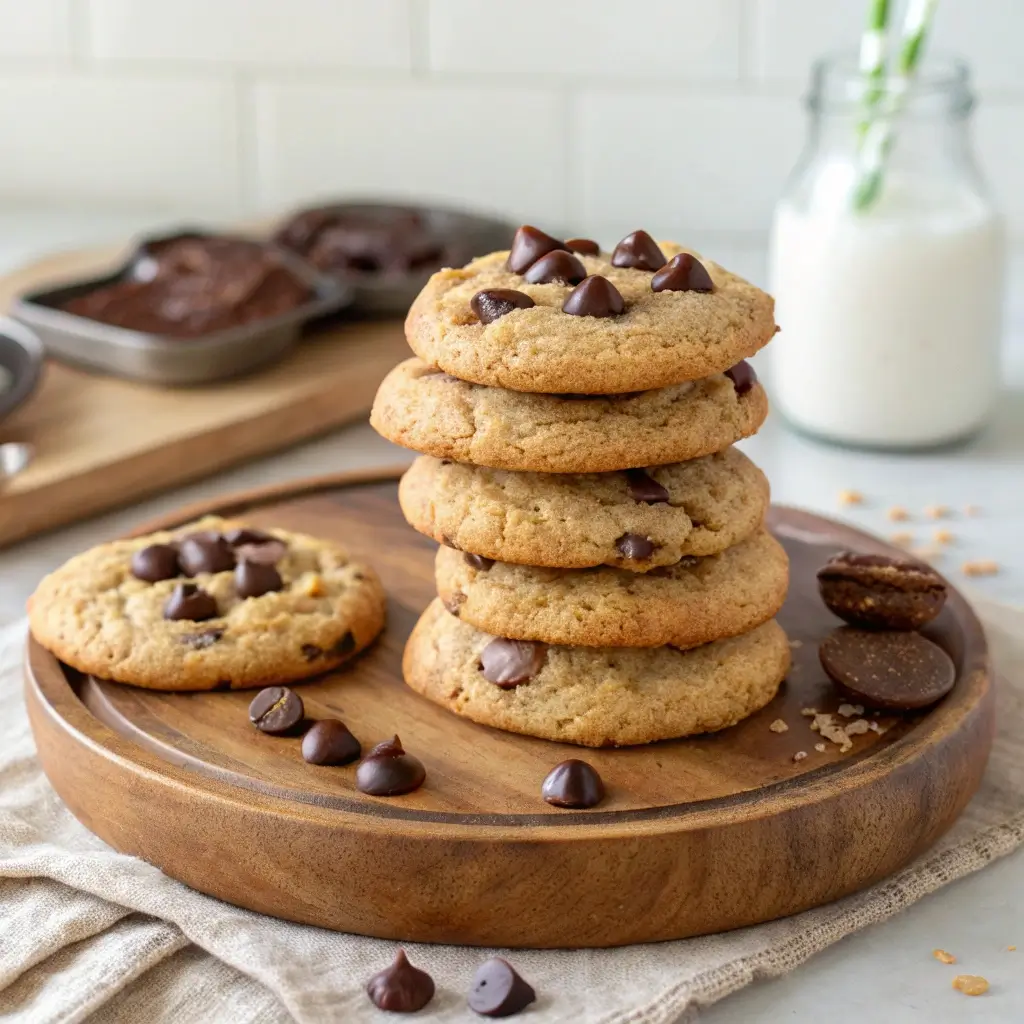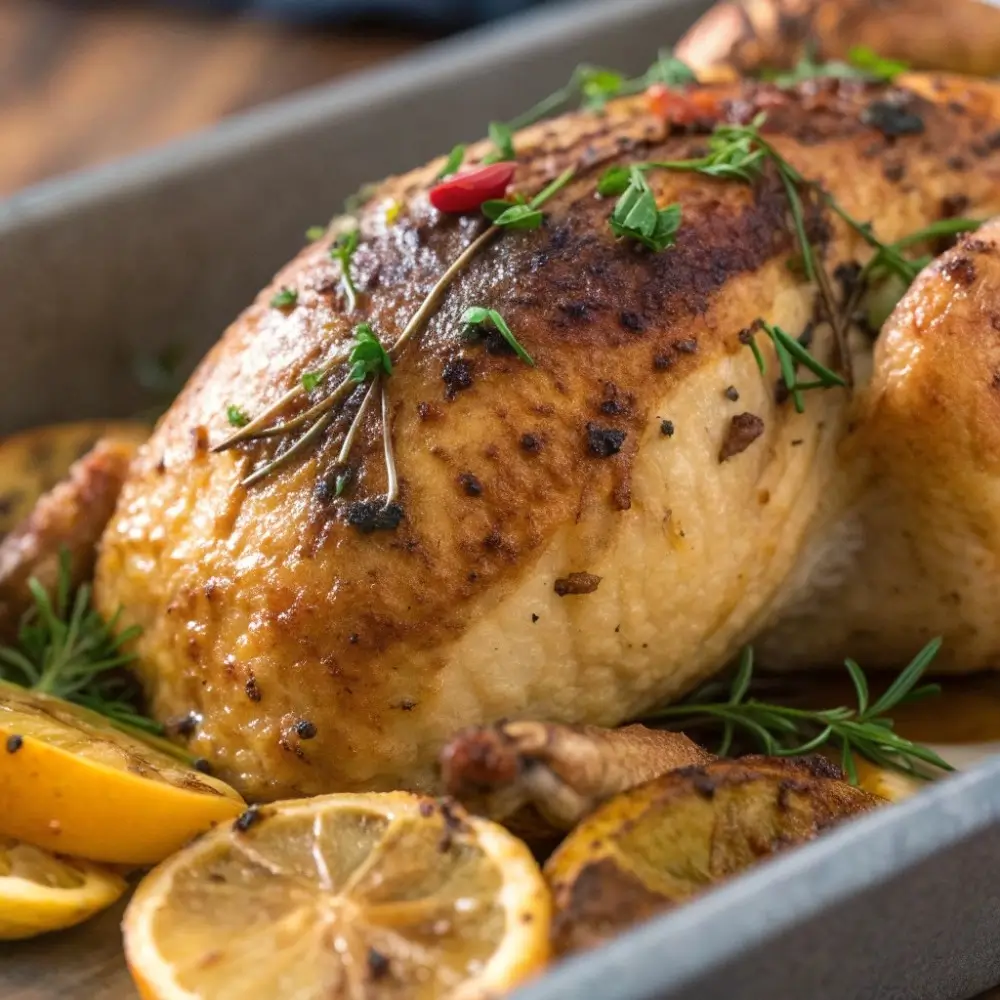Table of Contents
Have you ever wondered what to do with leftover sourdough discard? One of the most fun — and delicious — answers is soft and chewy sourdough discard cookies. These cookies combine the comforting chew of a classic chocolate‑chip cookie with extra moisture and flavor from your discard, turning what might go to waste into a batch of sweet treats.
If you love baking, sourdough, or just cookies in general, these are a must‑try. They’re kid‑friendly, crowd‑pleasing, and forgiving for home bakers. You won’t taste sourness; the discard enriches texture and adds subtle depth.
In this article you’ll find:
-
Full ingredients list with notes
-
Step‑by‑step instructions and baking tips
-
Variations, add‑in ideas, and substitutions
-
Storage and serving suggestions
-
Troubleshooting common issues
-
Frequently asked questions
Let’s get baking some cookies that are soft, chewy, and unforgettable.
Ingredients & Notes
Here is a recipe for about 18–24 medium cookies (depending on scoop size).
Cookie Ingredients
| Ingredient | Quantity | Purpose / Notes |
|---|---|---|
| Sourdough discard (unfed) | ½ cup (≈ 120 g) | Adds moisture and contributes to chew |
| Unsalted butter | ½ cup (113 g), softened | Fat base for rich flavor and tender crumb |
| Granulated sugar | ⅓ cup (≈ 65 g) | Sweetness and helps with crisp edges |
| Brown sugar | ⅔ cup (≈ 135 g), lightly packed | Adds chewiness and depth |
| Egg | 1 large | Binds ingredients and structure |
| Vanilla extract | 1 teaspoon | Aroma and flavor lift |
| All‑purpose flour | 1½ cups (≈ 190 g) | Structure and base of dough |
| Baking soda | ½ teaspoon | Leavening and slight spread |
| Salt | ½ teaspoon | Balances sweetness |
| Optional mix‑ins: chocolate chips, chopped nuts, dried fruit | ½ to ¾ cup | Adds texture and flavor contrast |
Ingredient Notes & Tips
-
Make sure your discard is not overly runny; if liquid, you can drain or reduce the amount slightly.
-
Butter should be softened (not melted); room temperature makes mixing easier.
-
Use a mix of granulated + brown sugar to balance chew versus crisp edge.
-
The dough should be soft, slightly sticky, but manageable.
-
Avoid overmeasuring flour (fluff, spoon, level or weigh) to maintain softness.
-
Using quality chocolate chips or chunks elevates the cookie experience.
Step‑by‑Step Instructions
Prep Work
-
Preheat your oven to 350 °F (175 °C).
-
Line two baking sheets with parchment paper or silicone mats.
-
If desired, chill the dough briefly (10–15 minutes) to help control spread.
Cream Butter & Sugars
-
In a mixing bowl, cream the softened butter, granulated sugar, and brown sugar together until light and fluffy (about 2–3 minutes with a hand or stand mixer).
-
Add the egg and vanilla, mix until combined and smooth.
-
Stir in the sourdough discard until the mixture is uniform.
Combine Dry Ingredients
-
In a separate bowl, whisk together the flour, baking soda, and salt.
Mix Wet + Dry
-
Gradually add the dry ingredients into the wet mixture, mixing on low or by hand just until no dry streaks remain. Don’t overmix.
-
Fold in your chosen mix‑ins (chocolate chips, nuts, etc.) gently so as not to overwork dough.
Scoop & Bake
-
Using a cookie scoop or tablespoon, portion dough onto prepared baking sheets. Leave about 2 inches between cookies to allow spreading.
-
(Optional) Press a few extra chocolate chips lightly into tops of the dough mounds for appearance.
-
Bake one sheet at a time for about 10–12 minutes, until edges are set but centers remain soft. The tops may look slightly underdone — that’s perfect for chewiness.
-
Rotate the sheet halfway through baking for even browning.
Cool & Serve
-
Let cookies rest on the hot pan for 5 minutes (carryover heat helps set the centers).
-
Then transfer to a wire rack to cool completely.
-
Store cooled cookies in an airtight container.
Texture, Flavor & What to Expect
-
The ideal cookie is soft in the middle, chewy, with lightly crisp edges.
-
The sourdough discard adds nuanced richness without sour flavor.
-
A slight crinkle or crackle on top is a nice visual and texture cue.
-
Variations (nuts, dried fruit, extra chips) bring additional texture contrast.
Variations & Substitutions
Here are creative adaptations and options:
-
Double chocolate cookies: Add 2 tablespoons unsweetened cocoa powder (reduce flour slightly), plus chocolate chips.
-
Nutty chew: Fold in chopped walnuts, pecans, or hazelnuts (¼–⅓ cup).
-
Oat and raisin style: Substitute ¼ cup flour with rolled oats and fold in raisins or cranberries.
-
Peanut butter swirl: Drop small dots of peanut butter on dough and swirl lightly with a toothpick.
-
White chocolate & macadamia: Use white chocolate chips and macadamia nuts.
-
Vegan / dairy‑free:
-
Use vegan butter or margarine.
-
Use a flax egg (1 Tbsp ground flax + 3 Tbsp water) or commercial egg replacer.
-
Use dairy‑free chocolate chips or chunks.
-
-
Gluten‑free version: Use a 1:1 gluten‑free flour blend with xanthan gum or a binder — check texture as you go.
-
Storing dough: You can refrigerate dough (covered) for up to 24 hours before baking — flavors deepen, and dough firms.
-
Cookie bars / slab option: Press dough into a square pan and bake as blondies/brownies style. Adjust bake time (perhaps 20–25 min).
Storage, Keeping & Serving
-
Keep baked cookies in an airtight container at room temperature for up to 4–5 days.
-
Place a slice of bread or a piece of apple in the container to help cookies stay soft (replace as needed).
-
You may freeze baked cookies (well wrapped) for up to 2 months; thaw at room temperature.
-
You can also freeze scoops of unbaked dough (on a tray) and then transfer to freezer bags. Bake from frozen, adding a minute or two to bake time.
-
Warm slightly before serving (microwave 5–7 seconds) to re‑soften centers if needed.
Troubleshooting & Common Issues
| Problem | Likely Cause | Solution |
|---|---|---|
| Cookies spread too much / too flat | Dough too warm, too little flour, overly softened butter | Chill dough briefly, reduce butter or add a tablespoon more flour |
| Cookies too thick, cakey | Too much flour, underbaked, too high leavening | Verify measurements, bake fully, check baking soda amount |
| Hard or dry centers | Overbaked | Remove when edges are set but centers still soft |
| Tough texture | Overmixing | Mix just until combined, don’t overwork gluten |
| Dough too sticky to handle | Discard too wet, butter too soft | Chill dough or add a small amount of flour as needed |
| Undercooked middle | Oven temp too low, inaccurate timing | Use oven thermometer, increase bake time slightly |
Serving Suggestions & Pairings
-
Serve fresh cookies with cold milk, coffee, or tea.
-
Pair with ice cream or a scoop of vanilla or salted caramel for a dessert treat.
-
Build a dessert plate: cookies, berries, whipped cream.
-
Drizzle melted chocolate or caramel over warm cookies.
-
Sandwich two cookies with frosting, Nutella, or jam for cookie sandwiches.
-
Crumble into yogurt, parfaits, or ice cream sundaes for texture and flavor boosts.
Frequently Asked Questions
Do these cookies taste sour from the discard?
No — these cookies do not have a noticeable sour flavor. The discard adds moistness and depth, but the sweetness, chocolate (or mix-ins), and butter dominate.
Can I use active starter instead of discard?
Yes — you may use active starter. Adjust moisture accordingly; if your starter is stiffer or more hydrated, modify flour or wet ingredients slightly.
Do I need to feed the starter before using it for this?
No — this recipe is intended for using unfed discard, so you don’t need to feed your starter just before baking.
Can I bake these as bars or slab cookies instead?
Yes — press the dough into a parchment‑lined pan (e.g. 8×8”) and bake for about 15–20 minutes (timing depends on thickness). Watch for set edges and soft center.
How do I get clean cookie edges when cutting bar form?
Let the baked slab cool fully. Use a very sharp knife, warm if needed, and wipe between cuts. You may chill the slab slightly for firm slicing.
Can I reduce sugar?
You can slightly reduce granulated sugar (e.g. by 1–2 Tbsp), but reducing too much may affect texture and chew. Trial small adjustments.
Do I have to chill the dough?
Not strictly, but chilling 10–15 minutes helps control spread and gives cleaner, thicker cookies, especially in warmer kitchens.
Can I mix in other flavors (spices, extracts)?
Yes — a pinch of cinnamon, nutmeg, or even a splash of almond extract can complement the cookie base. Just use cautiously.
Why are my cookies not chewy?
Often because of too much flour, overbaking, or overmixing. Be precise with measurement, bake until just done, and mix gently.
Final Thoughts
These Soft & Chewy Sourdough Discard Cookies are a brilliant fusion of comfort baking and sourdough savvy. They transform your extra discard into a batch of treats everyone will devour. With chewy textures, mix‑in possibilities, forgiving dough, and delightful results, they’re a staple you’ll bake again and again.





